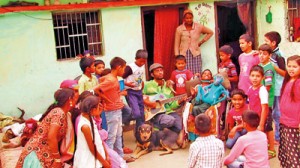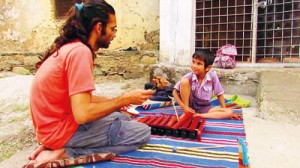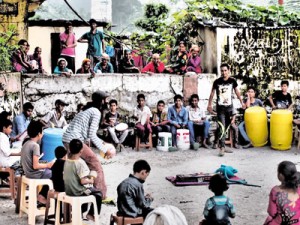Arts
Making music in the Himalayas
View(s):By Smriti Daniel

Making a difference through music: Deepak, suffering from cerebral palsy enjoys the company and music
Back home from the remote Himalayan village he lives in most of the year, Stephen Philip is already thinking about the children waiting for him there. The Sri Lankan music therapist uses techniques like dholgol or drum circles to bring people together. He will be raising funds to support that work through a unique, promenade style theatre event at Sooriya Village on June 25 which will draw on the talents of an eclectic group of Sri Lankan performers.
Excerpts from his interview:
Tell us about the place you live and work in. How did you find your way there?
I live in Matli, a Himalayan village which is relatively near to the border of Tibet. Matli is about 10 miles away from Uttarkashi, a fairly well known stop off point for pilgrims travelling to the mouth of the Ganges.
The setting is very rural, and given my preference for rural over urban living, I would say I felt “a tug at my heart” when I first visited in 2013, as part of a summer internship where I helped out at the mission school for a month.
I eventually came back in 2015, and find myself loving the place and the work I get to be a part of.
Could you explain how music therapy works? What are some of the key techniques you use?
Music is one of the few, and perhaps possibly the only sensory experience that can activate all areas of the brain, simultaneously.
This has widespread implications and opens up a variety of possibilities for using music as a therapeutic intervention. Music therapists today work primarily with client’s development delays, psychological issues, or physical and multiple handicaps, either as a complimentary or primary form of medical intervention.
Music therapy employs a broad range of techniques which can be divided roughly into active and receptive methods. Making music in the form of singing, chanting, playing, composing or improvising fall into the category of active techniques.
On the other hand listening to and responding to music in the form of dance, movement, analysing lyrics, are receptive techniques. Active and receptive techniques are often combined during treatment, and both are used as starting points for the discussion of feelings, values, and goals.
There is this beautiful video of your playing percussion for Deepak, a boy with cerebral palsy. Could you tell us about him, and how the music affects him?
I’ve known Deepak since my first visit in 2013, where I met him in his wheel-chair, sitting in the sun, covered with flies, and not able to do anything about it! I remember feeling incredibly frustrated and helpless when I first saw him.

The magic of a drum circle in a mountain village. Pix courtesy Stephen Philip
Deepak has a severe case of Cerebral Palsy, where damage to his brain has affected both his arms and legs, along with the muscles of his spine and mouth.
Since my return in 2015, there has been a physiotherapist within our community who spent lots of time caring for Deepak, so for the best part of the last two years I’ve not had a lot of interaction with Deepak. The beginning of this year however saw me shifting house right next to Deepak’s, from where I have the joy of visiting him and seeing his smile pretty much everyday.
Since music affects pretty much every area of the brain, music therapy can, and does make large contributions to the lives of those with Cerebral Palsy. Musical input travel via the auditory nerve to the brain, where after being processed, have some of these inputs delegated to the motor nerves in our spinal cords.
This allows the muscles to move to rhythm without having to think of it – as in the case of us unconsciously tapping our feet to not just music we enjoy, but at times to music which may not always fit our taste buds. Additionally listening to music releases “dopamine,” the feel good hormone in our brain.
This, along with our motor system’s natural ability to entrain and match rhythm, results in Deepak unconsciously having a “rocking” full body work out, with what would otherwise be painful and tedious exercise for him to prevent his muscles from further stiffening up.
How can music therapy go beyond an individual to contribute to the well-being of the wider community?
One of the really enjoyable experiences in my work are the weekly drum circles which I conduct in a village higher up in the mountains.
The team I work with travel to the drum circles with Jagu, a large brilliant blue (toy) monkey – in a tempo, an Indianized small-scale version of the open back double cab.
The drum circle has evolved into quite the event: Farmers leave their fields, the village elders leave their card games, mothers come carrying babies, younger adults climb trees to sit around the already gathered circle of children, supporting by way of clapping, instructing, and even dancing.
As a team, we often find ourselves in the middle of transcendental experiences, as there is something beautiful and powerful about making music together with an entire village in sync with each other.

One man journey: Stephen Philip who believes in the power of music therapy
Traditional power structures are challenged by participatory practices, and there is an expectation that all the diverse voices engaged in the process have the right to be heard and made welcome.
In the last year, I’ve observed that these communal music making gatherings tend to subtly contribute to a wider social change agenda, even when this is unintended. My work with Deepak seems to bring this to the forefront, for music has created a platform for him to be considered as a part of community.
This happens now on Sunday afternoons, when a group of children who come over to my house to play, end their playtime by visiting Deepak and singing to him. This is a two way education, with Deepak experiencing what it is like to belong to a group, or a “gang,” and the visiting children, family, and community get to interact with Deepak as a human.
In a context where disabled children are stigmatized, hidden away, and sometimes even viewed as been cursed of god, music is facilitating the breaking of a huge cultural mind-set.
Why are you raising funds? What can audiences expect from your fundraiser?
The fundraiser is primarily to meet my rent expenses for a new music therapy space, this coming year. I will be shifting from the room I rented for the last year, and need to rent two new rooms for the music therapy clinic.
Additionally, I also hope to purchase more non-musical resources to meet the needs of some of the children with learning difficulties and physical handicaps.
The fundraiser will be staged in the style of Promenade theatre, with the intention of allowing those present to have a therapeutic experience of the arts.
This will include sing-a-longs, live voice manipulations synthesized with digital effects, a taste of an experiential drama therapy session, communal music therapy activities, and a time to view the work of the event facilitator in the Himalayas.

Leaving their chores aside: Women folk join a communal music-making gathering
The event will feature Sean Amarasekera, a doctor who sings and is actively involved in theatre; Subha Wijesiriwardena, a writer who has worked in theatre; Tehani Chitty, a drama therapist and actor; Marisa De Silva an activist who has performed with all female choir, Soul Sounds since its inception in 2004; Ranjan Josiah, a musician; Chanaka Abeyratne, a chilled out metal head, musician, and sound engineer; and Nisho, a lover of music, musician, and sound engineer.
Having to carry out this event without the presence of my team back in the Himalayas is somewhat lonesome as they have been such a strong and supportive presence throughout the last year, without whom nothing much would have been accomplished. A huge thanks to them, Ankur, Shiny, Abhishek, Vinay, Alish, and Mojesh.
| “DholGhol : A Fundraiser in Aid of Himalayan Music Therapy” is on June 25 from 6.45 p.m. – 8.45 p.m., at “Sooriya: The Village.” Entrance will be via tickets available at the entrance. Alternatively Stephen (0719830118) can be contacted for pre-bookings. Tickets will be priced at Rs. 1000 for adults and 750 for children below 12. More details on: https://www.facebook.com/events /255630644914933/ | |

